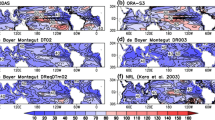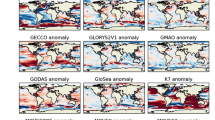Abstract
Variability of the Pacific Ocean is examined in numerical simulations with an ocean general circulation model forced by observed anomalies of surface heat flux, wind stress and turbulent kinetic energy (TKE) over the period 1970-88. The model captures the 1976-77 winter time climate shift in sea surface temperature, as well as its monthly, seasonal and longer term variability as evidenced in regional time series and empirical orthogonal function analyses. Examination of the surface mixed-layer heat budget reveals that the 1976-77 shift was caused by a unique concurrance of sustained heat flux input anomalies and very strong horizontal advection anomalies during a multi-month period preceding the shift in both the central Pacific region (where cooling occurred) and the California coastal region (where warming occurred). In the central Pacific, the warm conditions preceding and the cold conditions following the shift tend to be maintained by anomalous vertical mixing due to increases in the atmospheric momentum flux (TKE input) into the mixed layer (which deepens in the model after the shift) from the early 1970s to the late 1970s and 1980s. Since the ocean model does not contain feedback to the atmosphere and it succeeds in capturing the major features of the 1976-77 shift, it appears that the midlatitude part of the shift was driven by the atmosphere, although effects of midlatitude ocean-atmosphere feedback are still possible. The surface mixed-layer heat budget also reveals that, in the central Pacific, the effects of heat flux input and vertical mixing anomalies are comparable in amplitude while horizontal advection anomalies are roughly half that size. In the California coastal region, in contrast, where wind variability is much weaker than in the central Pacific, horizontal advection and vertical mixing effects on the mixed layer heat budget are only one-quarter the size of typical heat flux input anomalies.
Similar content being viewed by others
References
Alexander MA (1990) Simulation of the response of the North Pacific Ocean to the anomalous atmospheric circulation associated with El Niño. Clim Dyn 5:53–65
Alexander MA (1992) Midlatitude atmosphere-ocean interaction during El Nino. Part I: the north Pacific Ocean and part II: the Northern Hemisphere atmosphere. J Clim 5:944–972
Barnett TP (1981) On the nature and causes of large-scale thermal variability in the central North Pacific Ocean. J Phys Oceanogr 11:887–904
Barnett TP (1984) Long term trends in surface temperature over the oceans. Mon Weather Rev 112:303–312
Barnett TP, Latif M, Kirk E, Roeckner (1991) On ENSO physics. J Clim 4:487–515
Bleck R, Boudra DB (1981) Initial testing of a numerical ocean circulation model using a hybrid coordinate (quasi-isopycnic) vertical coordinate. J Phys Oceanogr 11:755–770
Bjerknes J (1969) Atmospheric teleconnections from the equatorial Pacific. Mon Weather Rev 97:163–172
Cardone VJ, Greenwood JG, Cane MA (1990) On trends in historical marine data. J Clim 3:113–127
Cayan DR (1990) Variability of latent and sensible heat fluxes over the oceans. PhD. Dissertation, University of California, San Diego
Cayan DR (1992a) Variability of latent and sensible heat fluxes estimated using bulk formulae. Atmos Ocean 30:1–42
Cayan DR (1992b) Latent and sensible heat flux anomalies over the northern oceans: the connection to monthly atmospheric forcing. J Clint 5:354–369
Cayan DR (1992c) Latent and sensible heat flux anomalies over the northern oceans: driving the sea surface temperature. J Phys Oceanogr 22:859–881
Cayan DR, Miller AJ, Barnett TP, Graham NE, Ritchie JN, Oberhuber JM (1993) A two-decade simulation of the Pacific Ocean forced by observed monthly surface marine observations. In: Climate von decade-to-century time scales. National Academy of Sciences press, Washington DC, 20418 (in press)
Davis RE (1978) Predictability of sea level pressure anomalies over the north Pacific Ocean. J Phys Oceanogr 8:233–246
Douglas AV, Cayan DR, Namias J (1982) Large-scale changes in north Pacific and North American weather patterns in recent decades. Mon Weather Rev 110:1851–1862
Ebbesmeyer CC, Cayan DR, McLain DR, Nichols FH, Peterson DH, Redmond KT (1991) 1976 step in the Pacific climate: forty environmental changes between 1968–75 and 1977–1984. In: Betancourt JL, Tharp VL (eds) Proceedings of the 7th Annual Pacific Climate (PACLIM) Workshop, California Department of Water Resources, Interagency Ecological Studies Program Technical Report 26
Folland CK, Parker DE, Kates FE (1984) Worldwide marine temperature fluctuations 1856–1981. Nature 310:670–673
Frankignoul C (1985) Sea surface temperature anomalies, planetary waves, and air-sea feed-back in the mittle latitudes. Rev Geophys 23:357–390
Gaffen DJ, Barnett TP, Elliot WP (1991) Space and time scales of global tropospheric moisture. J Clim 4:989–1008
Gill AE, Niiler PP (1973) The theory of the seasonal variability in the ocean. Deep-Sea Res 20:141–177
Goldenberg SB, O'Brien JJ (1981) Time and space variability of tropical pacific wind stress. J Phys Oceanogr 11:1190–1207
Graham NE (1991) Decadal-scale climate variability in the 1970s and 1980s: Obervations and model results. In: Proceedings of the Fifteenth Annual Climate Diagnostic Workshop, US Department of Commerce/NOAA/NWS/NMC/CAC PB9-1171082
Graham NE (1993) Decadal-scale climate variability in the 1970s and 1980s: observations and model results. Clim Dyn (in press)
Graham NE, Barnett TP, Schlese U, Bengtsson L (1993) On the roles of tropical and midlatitude SSTs in forcing interannual to interdecadal variability in the winter Northern Hemisphere circulation. Manuscript in preparation
Halliwell GR, Cornillon P (1989) Large-scale SST anomalies associated with subtropical fronts in the western North Atlantic during FASINEX. J Mar Res 47:757–775
Haney RL (1980) A numerical case study of the development of large-scale thermal anomalies in the central north Pacific Ocean. J Phys Oceanogr 10:541–556
Haney RL (1985) Midlatitude sea surface temperature anomalies: a numerical hindcast. J Phys Oceanogr 15:787–799
Haney RL, Shriver WS, Hunt KH (1978) A dynamical-numerical study of the formation and evolution of large-scale ocean anomalies. J Phys Oceanogr 8:952–969
Haney RL, Risch MS, Heise GC (1981) Wind forcing due to synoptic storm activity over the north Pacific Ocean. Atmos Ocean 19 (2):128–147
Hotel JD, Wallace JM (1981) Planetary scale atmospheric phenomena associated with the Southern Oscillation. Mon Weather Rev 109:813–829
Huang JCK (1979) Numerical case studies for ocean thermal anomalies with a dynamical model. J Geophys Res 84:5717–5726
Isemer H-J, Hasse L (1987) The Bunker Climate Atlas of the North Atlantic Ocean. Vol. 2: air-sea interactions. Springer, Berlin Heidelberg New York
Kashiwabara T (1987) On the recent winter cooling in the North Pacific. Tenki 34:777–781 (in Japanese)
Kitoh A (1991) Interannual variations in an atmospheric GCM forced by the 1970–1989 SST. Part 11: low-frequency variability of the winter time Northern Hemisphere extratropics. J Meteorol Soc Japan 69:271–291
Kitoh A (1992) Decade-scale interannual variations simulated in an atmospheric GCM using the observed 1970-1989 SST. In: Progress in climate study — report of the Japanese National Projects for WCRP 1987-1991 (in press)
Klein P, Hua BL (1988) Mesoscale heterogeneity of the winddriven mixed layer: influence of a quasigeostrophic flow. J Mar Res 46:495–525
Levitus S (1982) Climatological atlas of the World Ocea. US Department of Commerce. NOAA Prof Pap 13
Liu WT, Gautier C (1990) Thermal forcing on the tropical Pacific from satellite data. J Geophys Res 95:13209–13217
Luksch U, von Storch H, Maier-Reimer E (1990) Modeling North Pacific SST anomalies as a response to anomalous atmospheric forcing. J Mar Syst 1:155–168
Luksch U, von Storch H (1992) Modeling the low-frequency sea surface temperature variability in the North Pacific. J Clim 5:893–906
McLain DR (1983) Coastal ocean warming in the Northeast Pacific, 1976–1983. In: Pearcy WG (ed) The influence of ocean conditions on the production of salmonids in the North Pacific. Oregon State University, Sea Grant Program, ORESUW-83-001
Michaud R, Lin CA (1992) Monthly summaries of merchant ship surface marine observations and implication for climate variability studies. Clim Dyn 7:45–55
Miller AJ (1992) Large-scale ocean-atmosphere interactions in a simplified coupled model of the midlatitude winter time circulation. J Atmos Sci 49:273–286
Miller AJ, Oberhuber JM, Graham NE, Barnett TP (1992) Tropical Pacific Ocean response to observed winds in a layered general circulation model. J Geophys Res 97:7317–7340
Namias J (1963) Large-scale air-sea interactions over the North Pacific from the summer 1962 through the subsequent winter. J Geophys Res 68:6171–6186
Namias J (1976) Negative ocean-air feedback systems over the North Pacific in the transition from warm to cold seasons. Mon Weather Rev 104:1107–1121
Namias J (1978) Multiple causes of the North American abnormal winter 1976–77. Mon Weather Rev 106:279–295
Namias J, Yuan X, Cayan DR (1988) Persistence of North Pacific sea surface temperature and atmospheric flow patterns. J Clim 1:682–703
Nitta T, Yamada S (1989) Recent warming of tropical sea surface temperature and its relationship to the Northern Hemisphere circulation. J Meteorol Soc Japan 67:375–383
Oberhuber JM (1993) Simulation of the Atlantic circulation with a coupled sea ice - mixed layer - isopycnal general circulation model. Part I: model description and part II: model experiment. J Phys Oceanogr 22:808–845
Palmer TN, Sun Z (1985) A modelling and observational study of the relationship between sea surface temperature in the northwest Atlantic and the atmospheric general circulation. Quart J R Meteorol Soc 111:947–975
Pavia EG, O'Brien JJ (1986) Weibull statistics of wind speed over the ocean. J Clim Appl Meteorol 25:1324–1332
Peixoto JP, Oort AH (1992) The physics of climate. American Institute of Physics, New York
Posmentier ES, Cane MA, Zebiak SE (1989) Tropical Pacific trends since 1960. J Clim 2:731–736
Ramage CS (1986) A comparative analysis of marine records from ocean weather stations and merchants-ships. In: Woodruff SD (ed) Proceedings of a COADS Workshop, NOAA Techn Memo ERL ESG-23
Seymour RJ, Strange RR, Cayan DR, Nathan RA (1984) Influence of El Niflos on California's wave climate. In: Proceedings of the 19th International Conference on Coastal Engineering, American Society of Coastal engineering, Houston
Suga T, Hanawa K (1990) The mixed-layer climatology in the northwestern part of the North Pacific subtropical gyre and the formation area of subtropical mode water. J Mar Res 48:543–566
Tanimoto Y, Iwasaka N, Hanawa K, Toba Y (1992) Characteristics variations of sea surface temperature with multiple time scales in the North Pacific. J Clim (sub judice)
Trenberth KE (1990) Recent observed interdecadal climate changes in the Northern Hemisphere. Bull Am Meteorol Soc 71:988–993
Tokioka T, Kitoh A, Nakagawa S (1992) Relationships between monthly mean sea surface temperature anomalies and sea level pressure anomalies realized in a coupled atmosphere-ocean general circulation model. In: 2nd Int Conf on Modelling Global Climate Change and Variability (Abstr), 7-11 Sep 1992, MPI Hamburg
Venrick EL, McGowan JA, Cayan DR, Hayward TL (1987) Climate and chlorophyll a: long-term trends in the central North Pacific Ocean. Science 238:70–72
Xu J-S (1992) The joint normal modes of the coupled atmosphere-ocean system observed from 1967–1986. Max-Planck-Institut für Meteorologie, Hamburg, Rep no 78
Author information
Authors and Affiliations
Rights and permissions
About this article
Cite this article
Miller, A.J., Cayan, D.R., Barnett, T.P. et al. Interdecadal variability of the Pacific Ocean: model response to observed heat flux and wind stress anomalies. Climate Dynamics 9, 287–302 (1994). https://doi.org/10.1007/BF00204744
Received:
Accepted:
Issue Date:
DOI: https://doi.org/10.1007/BF00204744




